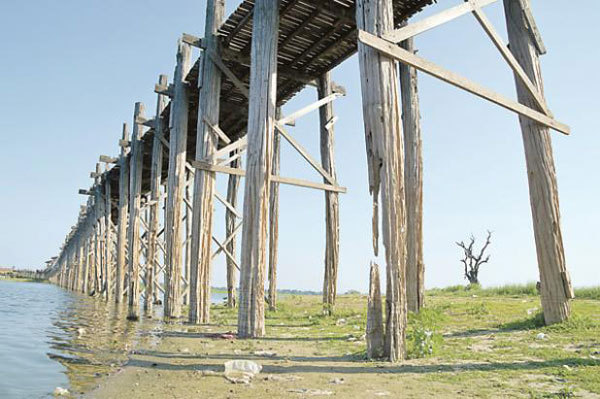The 160-year-old bridge, thought to be the world’s oldest and longest teak bridge, spans 1.2 kilometers across Taungthaman Lake in Amarapura, an ancient city near Mandalay
The famous U Bein Bridge is certainly one of the most photographed iconic sites near the northern city of Mandalay, but not many visitors are aware that the bridge is actually showing the ravages of time despite its sturdy teakwood architecture.
After over a century of exposure to the elements and natural disasters, the bridge has fallen into disrepair. Mandalay authorities are planning a major maintenance program even after a series of pillar replacements just a few years ago. The Mandalay regional government says the bridge’s structural deterioration necessitates urgent repair work.
The famous U Bein Bridge is certainly one of the most photographed iconic sites near the northern city of Mandalay, but not many visitors are aware that the bridge is actually showing the ravages of time despite its sturdy teakwood architecture.
After over a century of exposure to the elements and natural disasters, the bridge has fallen into disrepair. Mandalay authorities are planning a major maintenance program even after a series of pillar replacements just a few years ago. The Mandalay regional government says the bridge’s structural deterioration necessitates urgent repair work.

“As the bridge is old and aging, it has started dangerously decaying,” Mandalay Finance and Revenue Minister Myint Kyu said, adding: “We are drafting now for major renovation work on the bridge. Specific details will be released this week. We will submit the draft to the regional government, and we will be holding a press conference as well. Public suggestions are welcome.”
A major overhaul of the bridge is required because only minor repairs have been done in the past, critics say. The regional government spent Ks 13 million to repair the bridge in March 2013 because its pillars were badly decayed.
But repairing the bridge is no mean feat given its size and length. The 160-year-old bridge, thought to be the world’s oldest and longest teak bridge, spans 1.2 kilometers across Taungthaman Lake in Amarapura, an ancient city near Mandalay.
As repair work has not yet begun to return the bridge to its original glory, now is the best time to see the ramshackle bridge in its classic look.
Named after the mayor who had it built around 1849, the bridge originally had four resting places, 482 sections and 1,086 pillars taken from the former Innwa Palace that was flattened by a series of earthquakes in 1839. A new royal palace was subsequently erected in 1842 in Amarapura, 11 kilometers to the south of Mandalay. Established by King Bodawpaya in 1783, Amarapura was the center of power until 1857 when the capital was moved to Mandalay.
In its early days, U Bein was known as the ‘bridge without water’ because the lake was empty. With the introduction of irrigation, the lake was eventually flooded and became one of important freshwater fisheries.
Conservationists say the lake’s increasing pollution and water acidity have contributed to the bridge’s decaying foundations. A major restoration program began in 1995 to replace its teak pillars with concrete ones. But the effort sparked a heated debate about the impact of the bridge’s renovations on its historical value and original charm.
Local residents who are dependent on Mandalay’s tourisms for their survival are urging local authorities to repair the bridge urgently for fear that the city’s tourism will be undermined if the bridge collapses.
If you’re planning a day trip to Innwa or Sagaing, the U Bein Bridge is well worth a visit especially in the late afternoon when the bridge is buzzing with locals scurrying back home from work, some pulling their bicycles, others lumbering under the loads of firewood or ingredients for dinner perched atop their heads. There’s a row of teashops where you can relax while watching the human tide flowing back and forth across the lake.
By Htay Hla Aung
(Myanmar Eleven)
-
Articles by Korea Herald











![[Today’s K-pop] BTS pop-up event to come to Seoul](http://res.heraldm.com/phpwas/restmb_idxmake.php?idx=644&simg=/content/image/2024/04/17/20240417050734_0.jpg&u=)





![[KH Explains] Hyundai's full hybrid edge to pay off amid slow transition to pure EVs](http://res.heraldm.com/phpwas/restmb_idxmake.php?idx=652&simg=/content/image/2024/04/18/20240418050645_0.jpg&u=20240418181020)

![[Today’s K-pop] Zico drops snippet of collaboration with Jennie](http://res.heraldm.com/phpwas/restmb_idxmake.php?idx=642&simg=/content/image/2024/04/18/20240418050702_0.jpg&u=)